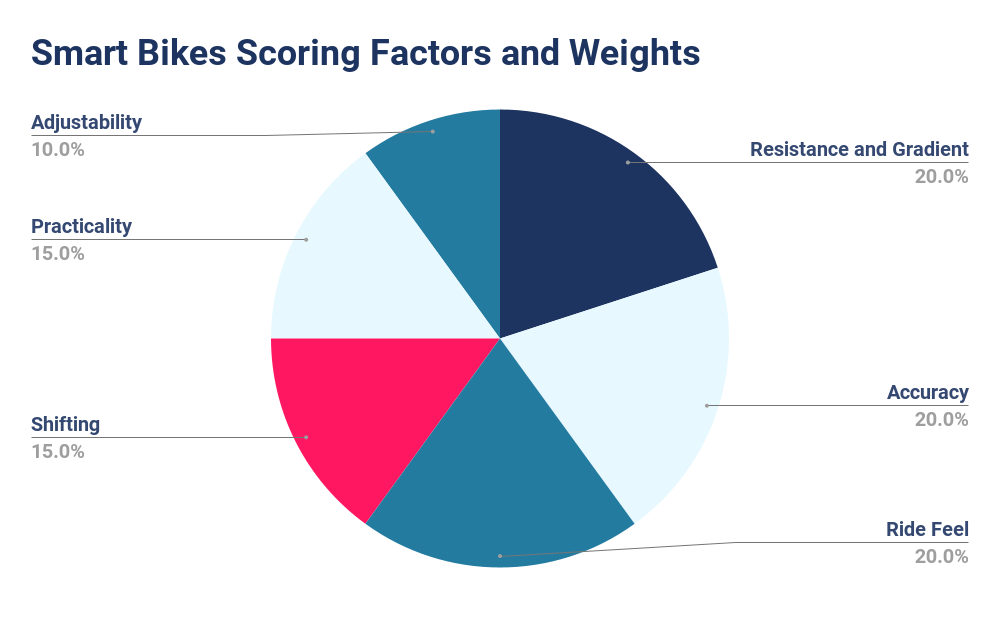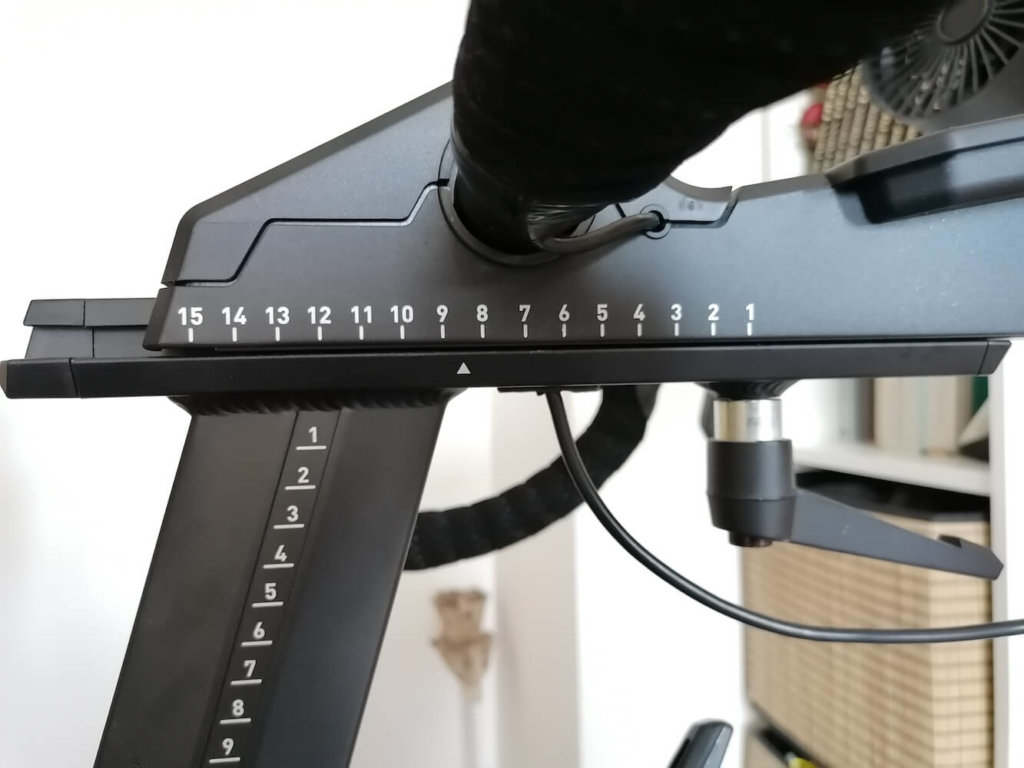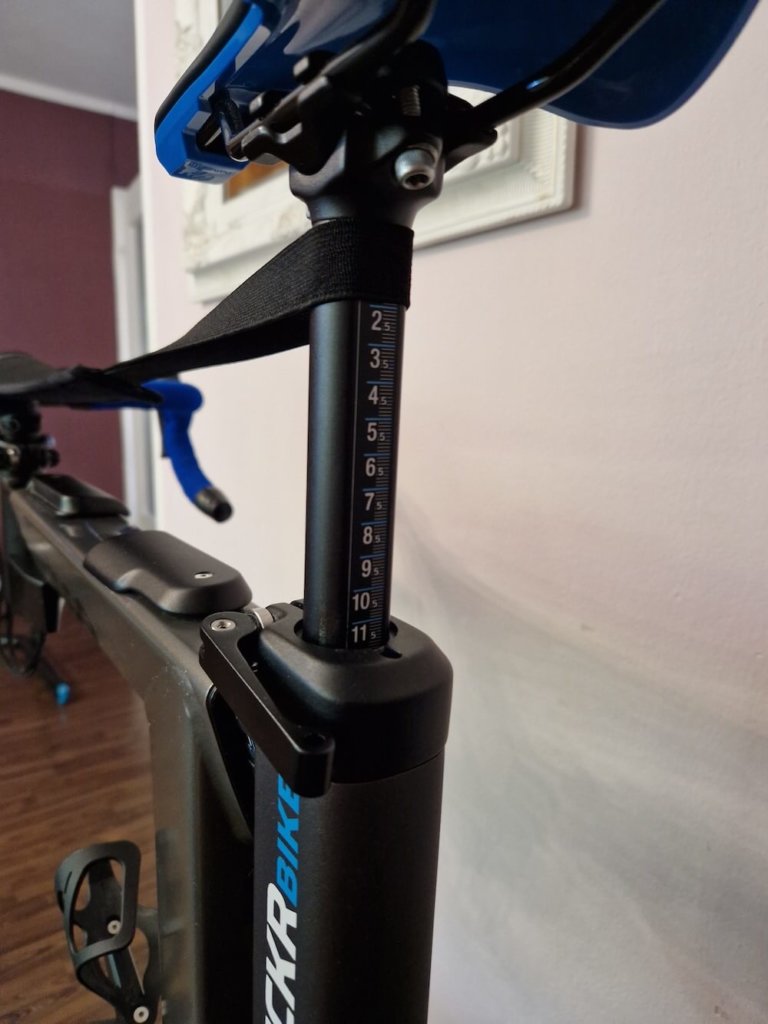On this page, I explain how I test and score smart bikes so you get a better idea of the details. Each category’s results contribute to my overall verdict on the smart bike’s quality.
I evaluate them on a scale of 1-5, where 1 is the worst and 5 is the best. It looks as follows:
Resistance & Gradient 3/5 | Accuracy 3/5 | Ride Feel 3/5 | Shifting 2/5 | Practicality 4/5 | Adjustability 2/5 | WEIGHTED OVERALL SCORE 3.0/5
Scores 1–2.5 are RED, 2.6–3.9 are ORANGE, and 4–5 are GREEN.
I score the following criteria on a scale mainly based on in-depth market research, which includes evaluating my and other owners’ experiences and comparing the smart bike features with competing alternatives. The scores are weighted, meaning each feature has a different importance. For example, the accuracy is more important than the adjustability.

I approach each power meter as objectively as possible. However, like everyone, I am subject to biases and expectations.
Scoring Criteria for Power Meter Features
Below is the list of the features of smart bikes with an explanation of the scoring.
Maximal Resistance and Gradient Simulation
The maximal resistance and gradient simulation tell you about the overall performance of the smart bike.
However, the values of most smart bikes are almost irrelevant to the majority of the population. They are so high that only some professionals can reach them.
On the other hand, a bike’s ability to quickly and accurately simulate gradient changes often goes hand-in-hand with its performance.
The ratings are as follows:
- 1 – The resistance is below 500W, and the gradient simulation is below 5%.
- 2 – The resistance is between 500 and 999W, and the gradient simulation is between 5 and 10%.
- 3 – The resistance is between 1000 and 1499W, and the gradient simulation is between 10 and 15%.
- 4 – The resistance is between 1500 and 1999W, and the gradient simulation is between 15 and 20%.
- 5 – The resistance is above 2000W, and the gradient simulation is above 20%.
For an illustration, here are the claimed maximum resistances of the best smart bikes:
And here are the claimed gradients:
Accuracy
I distinguish between claimed and measured accuracy. The claimed accuracy is that of the manufacturer. The measured accuracy is what I get from a series of tests and comparisons with other power sources.
The test series includes 3 basic tests:
- ERG mode
- Freeride
- Race
I convert the measured accuracy to positive numbers and average them. I do the conversion to find the average deviation from the base. If I averaged the values of, e.g., 1% and –1%, the deviation would be 0%, which is mathematically true, but realistically it gives a false idea about the bike’s accuracy. After the conversion, the accuracy is ±1%.
The main data source I use is Favero Assioma DUO power meters. They have a claimed accuracy of ±1% and are among the most reliable pedal power meters. I use them as a base. As another source, I use a Magene P505 spider power meter.
Before testing, I always update the smart bike to the latest firmware, warm it up by riding it for about 10 minutes, and perform the calibration. I don’t do manual calibration before each ride if the bike has auto-calibration. For smart bikes that I haven’t tested, I base it on the claimed accuracy.
Here are the points and the accuracy intervals.
- 1 – The accuracy is worse than ±4%.
- 2 – The accuracy is (±3-4%].
- 3 – The accuracy is (±2-3%].
- 4 – The accuracy is (±1-2%].
- 5 – The accuracy is better than ±1%.
For an illustration, here are the claimed accuracy rates of the best smart bikes:
Ride Feel
The ride feel is one of the most difficult features to describe. From my experience, smart bikes differ in how they can adjust the resistance when the gradient changes (in a 3rd party indoor cycling app) and whether they offer any extra features like surface simulation (Tacx NEO Bikes) or entire bike tilt (Wahoo KICKR bikes).
Therefore, ratings 1 and 2 are for dumb bikes, while the other three are for smart bikes:
- 1 – Slow and inaccurate responsivity to gradient changes.
- 2 – Slow or inaccurate responsivity to gradient changes.
- 3 – Decently accurate and quick responsivity to gradient changes.
- 4 – Quick and accurate responsivity to gradient changes, but the bike offers no extra features.
- 5 – Quick and accurate responsivity to gradient changes. The bike also offers extra features like surfaces or decline simulation.
Shifting
After pedaling, the second most common thing you’ll do on a smart bike is change gears. Each manufacturer uses a slightly different shifter design and gearing system. In this regard, Wahoo is the furthest along. Using their app, you can set up Shimano, SRAM, or Campagnolo shifting. The ergonomics of their shifters are also close to those we know from road sets.



At the other end of the spectrum are smart bikes with non-ergonomic shifters that have a limited choice of gear ratios and shifter behavior.
Therefore, the scoring is as follows:
- 1 – E.g., non-ergonomic shifters and no possibility to adjust gears.
- 2
- 3
- 4
- 5 – E.g., ergonomic, road-like shifters and easy adjustment of the virtual gears.
Practicality
In terms of practicality, I’m addressing whether the smart bike has a phone, tablet, or laptop holder. Then, whether there’s a place to put your water bottle or snacks, a charging port, and whether the bike has a display showing the gear you’re currently in.


Some smart bikes also have additional features, such as built-in fans or triathlon bars, which are especially welcomed by triathletes.
- 1 – E.g., a smart bike without a phone mount, a place to put a snack, and a charging port.
- 2
- 3
- 4
- 5 – E.g., a smart bike with a tablet mount, a place to put a snack, and a charging port.
Adjustability
The adjustability will be important to some people more than to others. Those who will set the bike and forget it will probably not care about this so much. However, those who want to use the smart bike with multiple people and change the bike fit will appreciate the ability to change it quickly.




Conversely, those who always have to set it up and clean it up will prefer its easy portability. Additionally, some smart bikes offer limited bike fit options, for example, only one crank length instead of five.
- 1 – E.g., the smart bike doesn’t offer easy adjustability of all important components and eventually, has an ineffective clamping system.
- 2
- 3
- 4
- 5 – E.g., the smart bike offers easy adjustability of all important components using a quick and efficient system (adjustment levers, knobs).
Conclusion
I try to be as objective as possible when testing bikes (and all other products). I aim to communicate my experience to potential buyers and help you make educated buying decisions.
Please remember that I am still tweaking and improving this procedure to provide you with the most valuable information possible.
I am open to suggestions on how to improve. Feel free to contact me. Here is the list of all the smart bikes I reviewed:
Recent Updates
- Feb 14, 2024: V1.0 testing procedure introduced.
